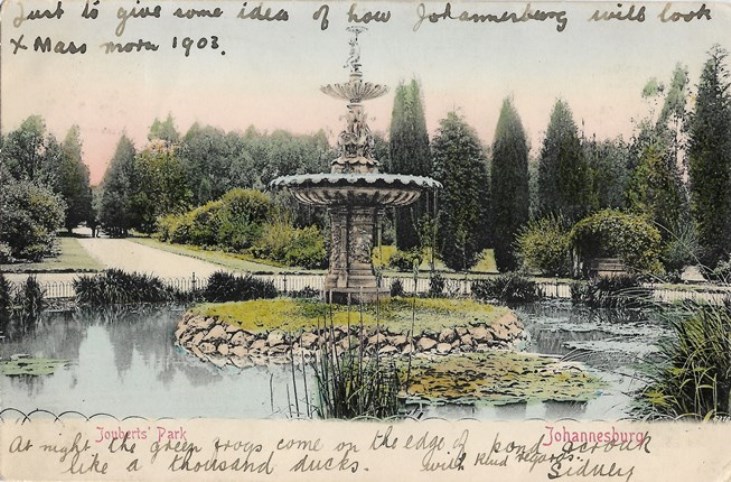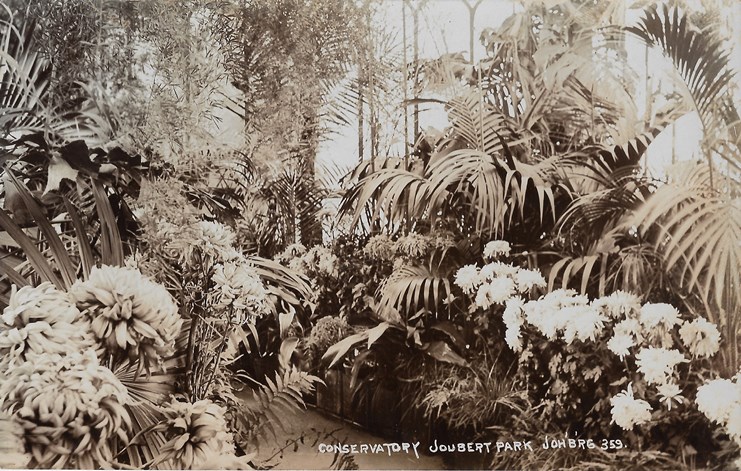TRANSVAAL PICTURE POSTCARD MESSAGES
JOHANNESBURG
Going to Australia ?
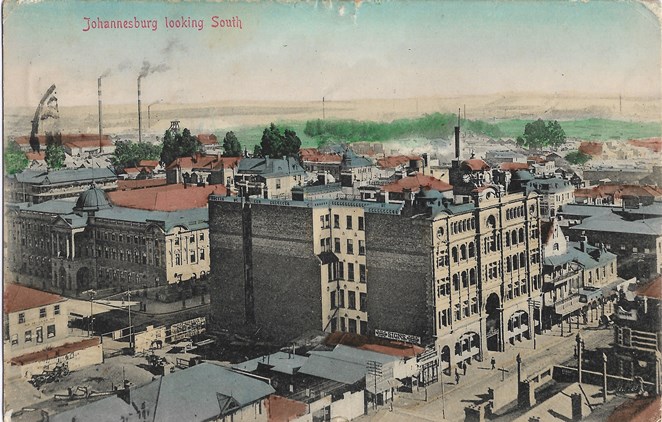
The Postcard
The picture postcard, number 2228, was published by Sallo Epstein & Co., Durban and captioned: 'Johannesburg looking South'. The divided back is printed in green and the postcard entered the post in Johannesburg before July 1908, addressed to "Miss Broom, ... New Road, Mumbles, Swansea, S, Wales, Gt Britain". The picture shows (at left) the new, domed, Stock Exchange in Holland Street, with its grand classical Porte-Cochére. The foundation stone was laid by Lord Milner on the 6th April 1903. In this city, 'built on gold', the buildings were never large enough for the ever-increasing activities; there were five Stock Exchange buildings over the hundred years up to 1978!
The Message
"Notice absence of people in Streets – all gone to or going to Australia - ErB’"
Note
The fun message is probably reflecting the Post-War depression, which occurred in the Transvaal Colony between 1904 and 1906 following a slump in 1903.
Fire
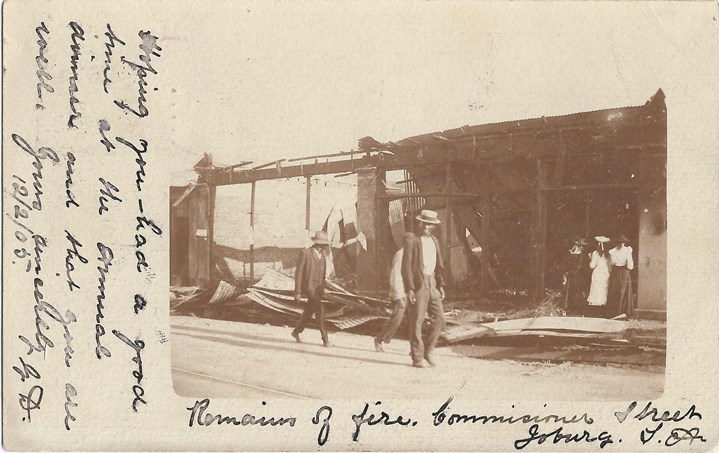
The Picture Postcard
Photographic postcard addressed to Bexhill-on-Sea, England entered the post on the 13th February 1906.
The Message
"Hoping you - had a good time at the Annual dinner and that you are well. Yours sincerely
13/2/05. G & D.
Remains of fire. Commissioner Street
Joburg. G. & D"
Note
Fires in towns and cities were fairly frequent when there were prolonged periods of dry weather, and where buildings were not always fireproof. Johannesburg was such a city, with many built from wood and iron; as recorded by Christopher Board on pages 182-183 in Barber, P., and Board, C., (1993), Tales from the Map Room, fact and fiction about maps and their makers, BBC Books, London.
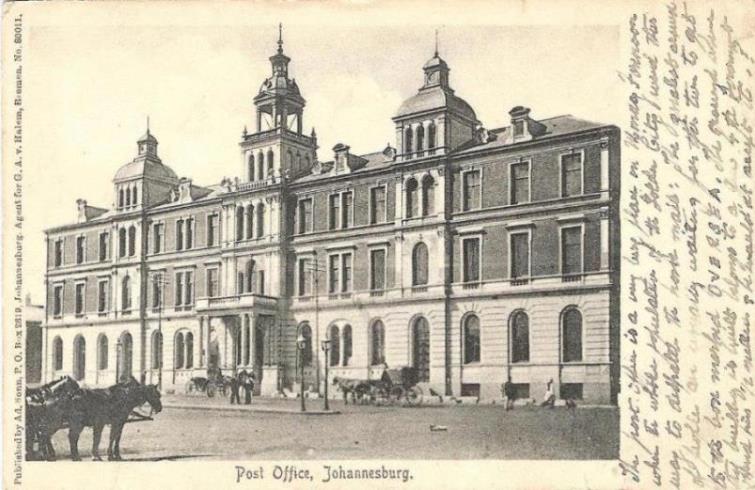
The Message
“The post office is a very busy place on Monday forenoon when the whole population of the Golden City wend their way to dispatch the home mail. The greatest crowd of people are usually waiting for their turn to get to the box marked OVERSEA. The ground where this building is built belongs to a Jew and the Government offered him ½ million & he would’nt accept it?”
The Postcard
On the address side is printed in black 'Post Card', and 'Printed in Germany'; there is no printed frame for a stamp. Captioned on the picture side and printed in ‘drab’ is ‘Post Office, Johannesburg’ and running up the left side ‘Published by Ad. Sonn, P.O.Box 2619, Johannesburg. Agent for G.A.v.Halem, Bremen No.80011.’
The picture is printed in black. Although the postcard is addressed to Scotland, it did not pass through the post as a postcard and was probably sent in an envelope. These postcards were in use from at least 31st March 1904.
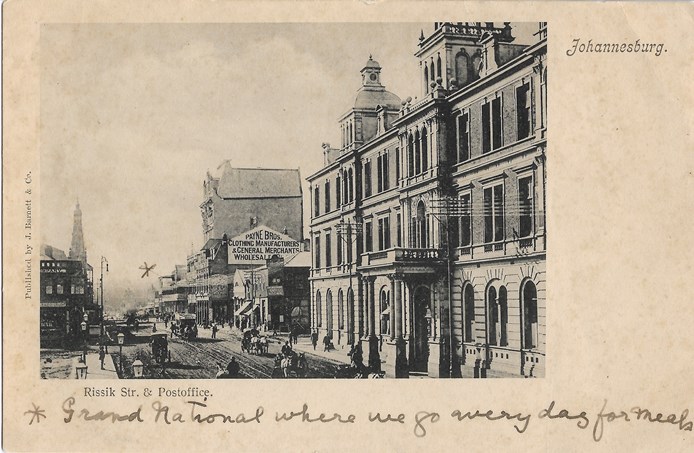
The Postcard
The picture is printed in black and the captions in drab. On the undivided back (address side) the only printed word is 'POSTCARD', which is also printed in drab. Perhaps both sides of the card were printed at the same time, by the method called 'work and turn'. Running up the left hand side of the picture, is the name of one of the foremost photographers and publishers in the city, Barnett & Co. These unnumbered picture postcards published by Barnett, are known by postmarks dating from July 1902, although many were posted in December of that year as 'Greetings Cards'.
Captioned 'Johannesburg’ / ‘Rissik Str. & Postoffice.', the view shows Rissik Street looking north with the Post Office to the right and Market Square to the left. The photograph was probably taken by David Barnett during the early months of 1902.
The Message
As with many picture postcards of the Edwardian period, the writer has added a "star" on the picture, in this case to indicate where May & Bob dined.
“ * Grand National where we go every day for meals” and on the address side, “To dear Connie & Alfred / With love & good wishes from / May & Bob.”
Note
During the first decade of the twentieth century, there was no shortage of places to eat in Johannesburg. The first low building on the east side of Rissik Street is Wellbourne Grill Rooms. However, May and Bob favoured the Grand National Hotel, further along that easten side of the street and situated on the corner of Rissik and Pritchard Streets. This was opposite, the 'Thurne Stuttaford Building', the popular upmarket 'Stuttaford Store' which is the tall building on the right. The Palace Building with its tall spire can be seen on the left.
Below is a detail from a later published picture postcard, to show the view looking in the opposite direction i.e. south. Grand National Hotel is to the left; the tall building is 'Stuttaford Store' and the General Post Office tower can be seen in the distance. In 1903 the Grand National Hotel's postal address was, Post Office Box, 885 or 5 & 6 Place Buildings, Pritchard and Rissik Streets, Johannesburg.
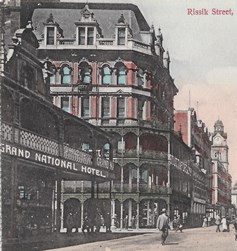
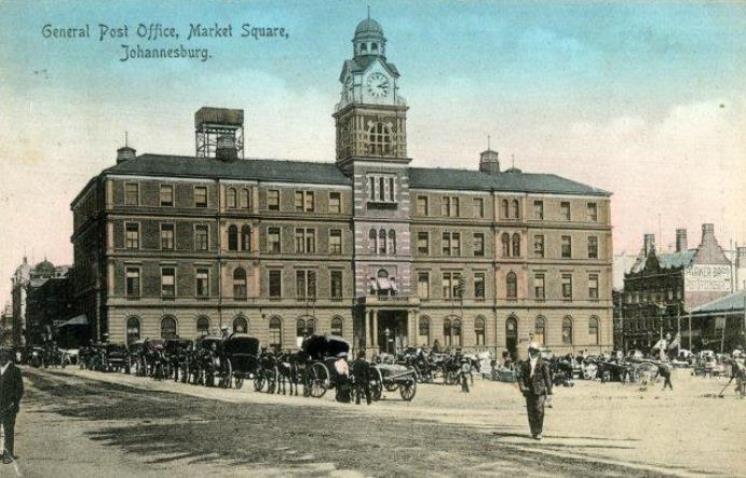
The Message
"This building is almost the largest in Joburg, but of some nothing like the London P.O. ... All the Postmen & Telegraph Boys are dressed in Khaki & red which I think looks too glaring & not to be compared with the Blue of home Postmen .?."
The Tenders for the supply of uniforms had been requested in The Transvaal Government Gazette on the 11th September, 1903; page 842. They were made locally and supplied by the end of the year. The sender of this postcard seemed unimpressed by both the architecture and the uniforms. Uniforms for London postmen had been introduced during 1890 and therefore the writer of this postcard was probably used to the appearance of uniformed postman at “home".
The Postcard
The 'P.S. & C.', Box.1470 - Johannesburg, picture postcard, was published by Paul Schaefer & Co., they also published picture postcards at: Durban, Box number 294 and Cape Town Box number 1205. It is captioned, 'General post office, Market Square, Johannesburg.' postcard number 1845. Addressed to London the postcard entered the post on 3rd June 1907, arriving on the 22nd June.
Reference
An article about Postmen's uniforms was published in The Transvaal Philatelist: Woolgar, J., Transvaal Edwardian Post Office Uniforms, (183) November 2012, pp.98-99 - see also Woolgar, J., (2021), ‘Transvaal, Postal Department Staff before and after the South African War’, Appendix Ten - The Supply of Uniforms 1903, p.93. (This book is now available in the UK – for more information, please email: Jeff and please add "New Book" to the email 'subject'.)
Frogs
